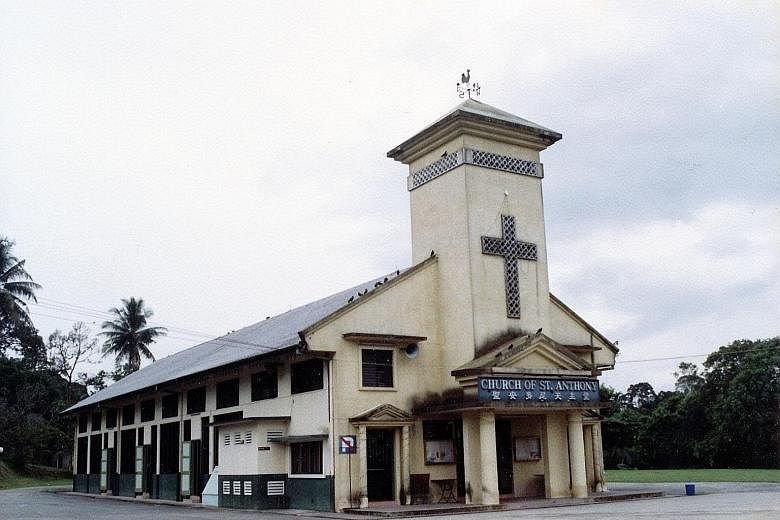To many people, Mandai may be associated only with the zoo but a recent study there has found that the area has many human interest stories too.
Just decades ago, deep in the heart of the hilly Mandai jungle used to lie a settlement for Catholic refugees who had moved here to escape persecution and political unrest in Swatow, China.
About 750 Teochew villagers found refuge here after arriving between 1927 and 1928.
For this, they had to thank the late Catholic priest, Father Stephen Lee, who wrote to the British government 50 times to ask for land in Mandai for the refugees to settle and cultivate crops.
This and other stories of Mandai were uncovered in a year-long study by a team from Singapore History Consultants (SHC), who were commissioned by developer Mandai Safari Park Holdings.
The wholly owned unit of Temasek Holdings is building a 126ha nature precinct in Mandai in phases, from 2020 to 2023.
The plan is to use the research to help conceptualise the development plans and design, based on authentic historical research of the area, said the developer.
The research could also be detailed in a heritage trail of the space in future.
SHC director Jeya Ayadurai said: "Initially, we saw just a large green area. We wondered if we would be able to find anything to share beyond the natural heritage.
"But we've uncovered this past world that was rich in layers of social, religious and economic history. Mandai has a story worth telling."
In recognition of Father Lee's efforts, the main road was named Stephen Lee Road by the then government. The road no longer exists but its original location can be found on land belonging to the Ministry of Defence today.
To further serve the refugees, Father Lee spearheaded the construction of a wooden chapel. A proper building called the Church of St Anthony was later constructed in 1960. This was relocated to Woodlands in 1994 due to planned redevelopment in Mandai.
The Cheng Chi Chinese Primary School was also built to serve the Catholic Village. There were at least six schools in Mandai, including Ban Lay School and the Nagammaiyar Tamil School.
According to old maps, Mandai was also home to several granite quarries - the Singapore Granite Quarries Mill, Seng Kee Quarry, Resource Development Corporation Quarry and Mandai Quarry.
The granite from these places, as well as those from Pulau Ubin, were used for the construction of the Causeway in the 1920s as well as the British Naval Base in Sembawang in the 1930s.
It was also used in the foundation work for roads, canals and Housing Board projects, said SHC.
A railway line by Topham Jones and Railton was constructed to support this industry.
The approximately 2km-long line connected with the main north-south line, which included stops such as Tanjong Pagar.
There were also rubber plantations in the area. The company Mandai-Tekong (Singapore) Rubber Estates once owned 196ha of land there. It had another 49ha in Pulau Tekong.
The SHC team, which carried out 16 expeditions into the Mandai forest, also discovered intact, remnant structures from the area's old kampungs and religious structures such as the Hu Tou Shan Temple.
Mr Jeya said: "There are foundations of old kampung houses, as well as pathways.
"Perimeter or boundary walls formed with granite from the quarries are also visible when you walk around."
The kampungs and community facilities were cleared in the 1980s as Singapore modernised. The land now belongs to Mindef, while another portion where the former Mandai Orchid Garden was sited belongs to the Singapore Land Authority. The zoo opened in Mandai in 1973.
Temasek's managing director of its enterprise development group Neo Gim Huay, who grew up in Mandai's Lorong Asrama, said her favourite months were June and December as these were months when fruits ripened. She would pick fruits such as rambutans with her cousins.
Ms Neo described the heritage trail as an "outdoor classroom".
She said: "Visitors will be able to walk the trails, visit the key landmarks and hear the stories of Mandai, perhaps, even learn how to pluck rambutans from the trees and draw water from the wells."
Heritage blogger and naval architect Jerome Lim welcomed the study on Mandai.
He said: "To most Singaporeans, Mandai is just the zoo. It is timely to weave aspects of the past there into a trail. For instance, the Singapore Armed Forces used the grounds of former rubber plantations for field training in the 1980s."
• To help deepen the research on the area, the public can send their stories of Mandai online at http://www.mandai.com/contact


